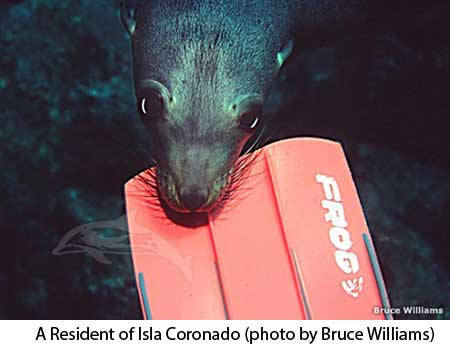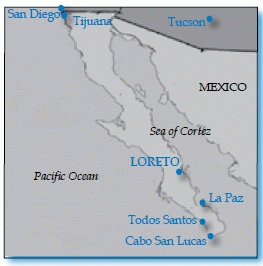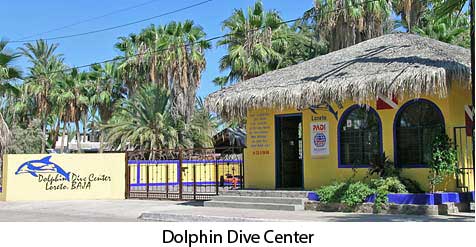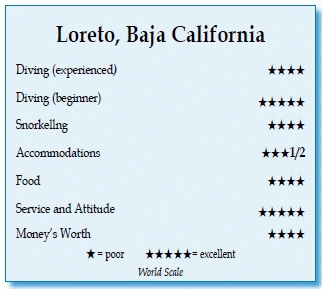Dolphin Dive Center, Loreto, Baja CA, MexicoContents of this Issue: Dolphin Dive Center, Loreto, Baja CA, Mexico Two Easy Ways to Recycle Your Dive Gear Cedar Beach Ocean Lodge, B.C., Canada Yes, Another High-Pressure Hose Recall Yes, the Dive Gear Caused His Death Why DEPP Has Been Giving the Silent Treatment to Divers The Debate About Fish and Pain is Settled -- Or Is It? Diving in “Shark-Infested” Waters Lionfish Control: Targeted Areas, Lots of Manpower Editorial Office: Ben Davison Publisher and Editor Undercurrent 3020 Bridgeway, Suite 102 Sausalito, CA 94965 dolphins and a mix of marine life in the Sea of Cortez from the February, 2013 issue of Undercurrent
Dear Fellow Diver: Chances are, your Baja California dive trip won't be like mine. I arrived in late October, a month after the peninsula received 21 straight days of rain, and a week after Tropical Storm Paul brushed past. The result: lush greenery everywhere, desert blooms in all colors. Was I diving the Caribbean or Baja California? Sometimes I got confused when I emerged from a dive and saw an emerald coastline. Baja's dry, red landcapes were nowhere to be seen; they were covered in green vines, grass and shrubs, and, most notably, the fuschia San Miguel flower. I was also here during off season, when neither whale sharks, Humboldt squid, nor Spring Breakers are hanging around, so I felt like I had the already quiet town of Loreto to myself. It's tucked away on the east side of the Baja peninsula, 225 miles from La Paz and 365 miles from Cabo San Lucas. It feels even more remote because the Sierra de la Giganta mountain range that looms up from the sea fences off the town from the flat plain behind it. If you want to avoid the "Housewives of Orange County" who come covered in sequins and animal prints on the flights down to Cabo, Loreto is your kind of place.
Diving here is mostly conducted around the five uninhabited islands across the bay from Loreto (Carmen, Coronado and Danzete are most visited, while Monserrate and Santa Catalina are farther south and require special-request trips), their 50-mile stretch making up the Loreto National Marine Park. Depending on wind and waves, the three islands closest to town take between 20 and 45 minutes to reach via fishing pangas that fill the marina and are used by Dolphin Dive as its dive boats. Loreto's marine park is the northernmost range for many tropical Pacific species that are present all the way down to South America. While the water was at its annual warmest, between 80 to 85 degrees, in late October, it's not warm enough on average for coral reefs, so marine life lives on coastlines of boulders, thick walks and rocky, rubbled bottoms. But as Chris and Jim, a veterinarian couple from Vancouver who dive here often, told me, the waters are "Sea Fan Heaven." I found that out as soon as we descended to the lone pinnacle of Piedra Blanca. Dozens of light green fern-like fan corals waved their greetings from the rocky bottom. Schools of wavyline and burrito grunts swam about. Barberfish and blue-and-gold snappers ignored me as I spiraled my way up the pinnacle. I saw the first of many moray eels and sergeant majors, and the eventually boring abundance of the latter was a running joke among the divers on my boat ("Gee, where are all the sergeant majors?" "Wow, I never saw so many as I have at THAT site!").
Rafa told me that he would see tons of bumphead parrotfish seven years ago, but now sees only a solitary few on random dives. Humboldt squid season had just ended, but he says he hasn't really seen them either in the last two years. The problem may be that Loreto's marine park currently doesn't give fish much protection. Rafa says there's an unspoken agreement that fishermen head to the park's southern boundaries and leave the northern part for tourists. But other divers told me they saw more fish the farther south they dived. My favorite dive had nothing to do with fish. On the backside of Isla Coronado, Rafa anchored the panga near barking sea lions resting on the ledge, while ospreys perched on nests high atop smooth, guano-stained cliffs. After we moved along sheer underwater walls at 70 feet, the sea lions came into view. The visibility was a crystal-clear 100 feet, and the sea lions were out in mass. I followed Rafa's lead, doing jumping jacks and sommersaults to get their attention, and the juveniles came in droves to check us out. A big one was either too playful or too cranky, first snapping at Rafa's fins, then the massive camera unit held by Jim, who backed off. But Jim and Dan, a Northern California banker who also dives here regularly, both told me this was the best sea lion dive they had done. On the rides back from Isla de Carmen and Coronado, Rafa spotted pods of bottlenoses and told Daniel, the boat captain (and his uncle) to head toward them. As we caught up to the pod, the dolphins sped alongside and below the bow, riding with us at 15 m.p.h. for a few minutes, jumping and flipping to our oohs and aahs. Loreto is tough to get to. From the U.S.,there's only one (pricey) flight a day. I had flown into San Jose del Cabo airport, the closest to Cabo San Lucas, because I had wanted to visit the charming colonial town of Todos Santos, an hour north of Cabo. I rented a car with Avis, which doesn't operate in Loreto, so I dropped it off in downtown La Paz and took the five-hour ride north in a 12-passenger bus run by EcoBajaTours. I had the comfortable AC ride nearly to myself, and the otherwise flat drive was beautiful, thanks to the exotic green lushness. After a stop in Ciudad Constitucion, the bus descended into a jagged canyon in La Giganta, then the aquamarine Sea of Cortez sparkled ahead.
But most people come here for kayaking, fishing (dorado, tuna, grouper) and diving. I chose the Iguana Inn because it was inexpensive (rooms are $55 or less per night), a block from the dive shop and had kitchenettes. I got a free upgrade from the smallest room to a bungalow because Hurricane Paul warnings had scared off some guests, and I was the only guest for three nights. The inn consists of four rooms, plus the owner's house, on a side street leading to the marina. Rooms 1, 2 and 3 have patios facing a shared outdoor area with a gas grill (Room 4 is in the back with its own private patio). DEET, Culligan water and a library of books are free to use. Room 1 was simple but clean, with a queen and a single, tiled bathroom and a well-stocked kitchenette, but only Mexican channels on the TV. Plenty of hot water in the shower and sink, and toilet paper goes into the wastebasket, common in most Baja bathrooms I used. Mike and Julie, former real estate brokers from Orange County, were gracious hosts and very responsive on the phone and e-mail to my questions. They confirmed my first day of dives with Dolphin Dive Center, and Julie gave me restaurant recommendations and all the need-to-know local gossip. When she saw me pick up The Girl Who Kicked the Hornet's Nest from the lending library, she told me I had to see the Swedish film versions of the Stieg Larsen triology, and immediately had Mike set up a DVD player in my room. Once the sun hit my window at 7 a.m., I made a breakfast of cereal and yogurt, then walked to Dolphin Dive Center for check-in at 8.15 a.m. While Rafa and Daniel prepped gear in the six-person panga, stored on a trailer hitch, we divers walked a half-block to the marina and waited a few minutes while the two men drove the panga over, backed it into the water and floated it to a slip by the jetty, where we boarded. At our first dive, Rafa got in the water first, while Daniel helped everyone put on their tanks before a backroll. We ascended together, and with only four to five divers on each of my dives, it was easy for us to stick together. While Rafa kept an eye on everyone, he let us go at our own pace.
Rafa is eager to please his customers, especially the photographers, by showing them marine life up close, but he clearly disrespected the animals. At Los Picachos, off Isla del Carmen, he irritated a balloonfish enough to make it puff up while fluttering by me. At the Coronado dive sites, he poked a stick into a crevice to get an iridescent Pacific spiny lobster to come out. The worst was when he found a hawksbill turtle resting in a dark cave. When the turtle saw us and immediately tried to exit, Rafa poked him three times with his hand so it would stay put while Jim readied his camera. Afterwards, Bill, a Boeing engineer from Seattle, said, "I felt kind of bad for that poor turtle. "Me too," I piped up. Rafa cast his eyes down and looked sheepish. Turtles must go to the surface to breathe; no one should ever hold them down. During my four days of diving, visibility was between 80 and 100 feet when the water was like glass. Wind later brought it down to 55 or 60 feet. My fellow divers wore 3-mm wetsuits; I rented a skinsuit at Rafa's suggestion, more to avoid the tiny stinging sea bugs floating on the surface, but it did come in handy at the lower depths, when the temperature was closer to 80 degrees. My aluminum 80 filled to 3,000 psi would last me about 50 minutes, then Daniel, who was always right there when I surfaced, took up my BC and fins before I climbed up the metal side ladder. Four divers were fine in the little panga, but add one or two more and it started getting claustrophobic, with sunny space to lay out wetsuits and towels at a premium. Rafa brought water and snacks for surface intervals on the boat, ranging from bananas and trail mix to coconut macaroons and apple muffins he bought at his local bakery. We were back at the marina by 3 p.m. at the latest but still, a long day without lunch. After a siesta, I walked Loreto's quiet streets or around the marina, where the malecon, or boardwalk, was only partially finished (the dirt-road part is fine for walking). Drug cartels and gang violence are a world away (many people told me that, like Carlos Slim, drug lords enjoy vacations in Baja, renting or owning homes there to lie low and get away from the violence), and the locals are very friendly. Just say "Hola" or "Buenos dias" to get a smile and start a conversation. Mexican is obviously the main cuisine. Orlando's, a block from the Iguana, has excellent food served on a palapa-covered, sandy-floored patio. The chili rellenos are great, and I enjoyed my plate of flautas, beef, rice, refried beans, corn tortillas and tomato salad for $8.50. Next door is the most popular ice cream shop in town, which offers a rainbow array of fresh-fruit popsicles, and chocolate sticks covered in everything, for $1 each. Loreto has plenty of full- and part-time expats, mostly living in "Gringo Gulch" complexes outside of town. Their favorite downtown hangout is Augie's, a bar south of the marina owned by Augie, a dead ringer for Roger Ebert before his jaw surgery. Local "characters" come for the daily happy hour from 4 to 7 p.m., with free appetizers and 2-for-1 drink specials. Unfortunately, it's all glass-windowed in, so no outdoor patio or seaside breeze. My favorite place for those was the Giggling Dolphin,a palapa-covered patio next door to Dolphin Dive Center, with a friendly manager and a TV turned to ESPN. A delicious chicken tortilla soup was $3, taco plates were $5. To fill up my kitchenette, I walked six blocks to the El Pescador supermarket. I should mention the Sea of Cortez's colorful collection of invertebrates. Pacific tube anemones in lavender, emerald and orange waved delicate, feathery tentacles in the current. Yellow polyp black coral, resembling floral bouquets, and vibrant red sea fans were everywhere. Crowned sea urchins crawled boldly on rocks, shyer purple sea urchins lodged in crevices. I was impressed with the range of sea stars, from the chocolate chip with a minty green bottom to the fiery multicolored brittle. My favorites were the shimmering Sally Lightfoot crabs, scrambling sideways for cover on the rocks at Isla Coronado. On my last day, we headed south to Danzete, a 40-minute boat ride along the coast, and anchored in the horseshoe of Honeymoon Bay. With its newly mossy-green mountains, it looked like Bora Bora. Again, diving was a hit, followed by a miss. At West Rock, we dropped down to a rubble bottom, then edged around boulders at 65 feet. Rafa pointed out a fine-spotted jawfish with huge eyes gaping out of the sand. It was aquarium diving, with schools of sergeant majors, chromis, and purple-grey trianglefish pouring over the rocks and around us. Twice, schools of big-eye jacks dashed past so fast I could hear them whizzing by. When I mentioned how I longed to see an octopus, Rafa took us to the mainland at Punta Coyote, a half-circle of rock jutting out from a cove. Visibility was poor -- all I saw were two zebra eels poking out before Rafa moved the rock covering them so that Karen, a visitor from Seattle, could photograph the jewel moray also in there. At the end of the dive, Rafa found a small octopus but he used his stick to pry it out from its hiding place three times. I wish I hadn't requested it. After a week in Loreto, I took another week to kayak the coast down to La Paz. When not kayaking, I was snorkeling, and I noticed that the farther south to La Paz we got, the fish were more plentiful, and the coral healthier and more vibrant. Schools of fish and healthy marine life are more reliably seen the farther down the Sea of Cortez you go. Still, Loreto is a great getaway from the crowds. Sea lions and dolphins are common, as are whale sharks in season, and when the wind and currents are working with you, dive sites offer up plenty to see, even when topside has gone back to its desert shades. Apparently, the Southern California-based owners of Dolphin Dive Center want to sell, and Rafa wants to buy it. If you're going to dive with him, be a good, environmentally-conscious diver and tell him he only needs to point the marine life out, not man-handle it. -- J.V.
|

I want to get all the stories! Tell me how I can become an Undercurrent Online Member and get online access to all the articles of Undercurrent as well as thousands of first hand reports on dive operations world-wide
| Home | Online Members Area | My Account |
Login
|
Join
|
| Travel Index |
Dive Resort & Liveaboard Reviews
|
Featured Reports
|
Recent
Issues
|
Back Issues
|
|
Dive Gear
Index
|
Health/Safety Index
|
Environment & Misc.
Index
|
Seasonal Planner
|
Blogs
|
Free Articles
|
Book Picks
|
News
|
|
Special Offers
|
RSS
|
FAQ
|
About Us
|
Contact Us
|
Links
|
3020 Bridgeway, Ste 102, Sausalito, Ca 94965
All rights reserved.

 It certainly
appeals to Carlos
Slim, the Mexican
billionaire who
dukes it out with
Bill Gates for the
title of world's
richest man. During
a surface interval
at Isla del Carmen,
a former salt mine
now turned private
island for trophy
sheep-hunting, I saw a huge white yacht in a cove downwind. "That
must be Slim's," Rafa, divemaster and manager
of Dolphin Dive Center, told me. "He loves
it here because it's so private and quiet,
and I see his boats a lot." At the next day's
interval at Isla Coronado, north of Isla del
Carmen, sure enough, there was Carlos, anchored
by a golden horseshoe beach. While helicopters
and kayaks are visible on board, Rafa doubts
the billionaire dives on his vacations.
It certainly
appeals to Carlos
Slim, the Mexican
billionaire who
dukes it out with
Bill Gates for the
title of world's
richest man. During
a surface interval
at Isla del Carmen,
a former salt mine
now turned private
island for trophy
sheep-hunting, I saw a huge white yacht in a cove downwind. "That
must be Slim's," Rafa, divemaster and manager
of Dolphin Dive Center, told me. "He loves
it here because it's so private and quiet,
and I see his boats a lot." At the next day's
interval at Isla Coronado, north of Isla del
Carmen, sure enough, there was Carlos, anchored
by a golden horseshoe beach. While helicopters
and kayaks are visible on board, Rafa doubts
the billionaire dives on his vacations. Fish life can be plentiful, colorful and diverse in the Sea of Cortez,
but in Loreto, sites were either a hit or a miss. At Las Lajas, a finger
formation at Isla Coronado, I swam over endless gray rubble and boulders with
no activity except for a green moray that came out its hole (that's why I
missed Rafa's discover of a tiger snake eel). But at La Lorbera, just up the
way, schools of grunts, juvenile angelfish, tang and ruddy-red Pacific creolefish
hovered above massive boulders that stood at 50 feet. I rose to 30
feet and looked down at all the schools, moving in traffic formations among
the rocky skyscrapers.
Fish life can be plentiful, colorful and diverse in the Sea of Cortez,
but in Loreto, sites were either a hit or a miss. At Las Lajas, a finger
formation at Isla Coronado, I swam over endless gray rubble and boulders with
no activity except for a green moray that came out its hole (that's why I
missed Rafa's discover of a tiger snake eel). But at La Lorbera, just up the
way, schools of grunts, juvenile angelfish, tang and ruddy-red Pacific creolefish
hovered above massive boulders that stood at 50 feet. I rose to 30
feet and looked down at all the schools, moving in traffic formations among
the rocky skyscrapers. As a mission town, Loreto is not as lovely as little Todos Santos, and it
doesn't have the array of amenities as Cabo or La Paz, but it works well as a
tranquil fishing village. It was the first Spanish settlement in Baja, and its
mission and plaza, the town's heart, is worth a visit. The town was celebrating
its 315th anniversary while I was there, hosting musical events and food
feasts every night for a week -- so I'm glad my hotel, the Iguana Inn, was not
in the town center. While there are charming small hotels around the plaza,
and it's typically quiet, nighttime activity could affect your sleep.
As a mission town, Loreto is not as lovely as little Todos Santos, and it
doesn't have the array of amenities as Cabo or La Paz, but it works well as a
tranquil fishing village. It was the first Spanish settlement in Baja, and its
mission and plaza, the town's heart, is worth a visit. The town was celebrating
its 315th anniversary while I was there, hosting musical events and food
feasts every night for a week -- so I'm glad my hotel, the Iguana Inn, was not
in the town center. While there are charming small hotels around the plaza,
and it's typically quiet, nighttime activity could affect your sleep. Rafa is a superlative divemaster
-- friendly, eagle-eyed, fluent in
English, and a former fisherman who
judges currents just by standing at the
bow and looking down. On a windy day
and after a choppy ride, Rafa decided
to go to Coronado a second day in a row
for the shallow site of Las Tijeretas,
but when he saw the current flowing
away from our destination, he had
us descend to the bottom, grab a bar
attached by rope to the boat's stern,
and hold onto it while Daniel drove us
close enough to the site so we didn't
have to fight much current. Unfortunately, the bar shifted down, knocking two
divers loose, so we ended up exploring a few rock formations at 75 feet. I
wouldn't recommend bringing up the subject of religion during conversation,
because Rafa is a passionate Pentecostal -- when he talked about how a local
was recently "cured" of homosexuality, there was a long, awkward silence before
someone changed the topic.
Rafa is a superlative divemaster
-- friendly, eagle-eyed, fluent in
English, and a former fisherman who
judges currents just by standing at the
bow and looking down. On a windy day
and after a choppy ride, Rafa decided
to go to Coronado a second day in a row
for the shallow site of Las Tijeretas,
but when he saw the current flowing
away from our destination, he had
us descend to the bottom, grab a bar
attached by rope to the boat's stern,
and hold onto it while Daniel drove us
close enough to the site so we didn't
have to fight much current. Unfortunately, the bar shifted down, knocking two
divers loose, so we ended up exploring a few rock formations at 75 feet. I
wouldn't recommend bringing up the subject of religion during conversation,
because Rafa is a passionate Pentecostal -- when he talked about how a local
was recently "cured" of homosexuality, there was a long, awkward silence before
someone changed the topic. Divers Compass: The one daily U.S. flight, from LAX via Alaska
Airlines, is around $450 round trip; Hertz, Alamo and Fox
have car rental offices downtown . . . If you're not comfortable
driving the two-lane road from La Paz for five hours,
the bus from La Paz leaves nearly every hour from the main
Malecon station for $53 one way, and they're comfortable, with
AC and movies; schedules and bookings are at
Divers Compass: The one daily U.S. flight, from LAX via Alaska
Airlines, is around $450 round trip; Hertz, Alamo and Fox
have car rental offices downtown . . . If you're not comfortable
driving the two-lane road from La Paz for five hours,
the bus from La Paz leaves nearly every hour from the main
Malecon station for $53 one way, and they're comfortable, with
AC and movies; schedules and bookings are at 